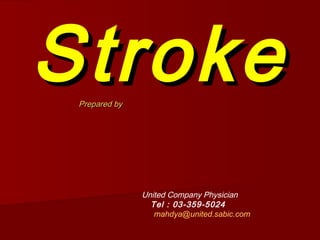
Strok / Serangan Angin Ahmar
- 1. Stroke Prepared by United Company Physician Tel : 03-359-5024 mahdya@united.sabic.com
- 2. !Stroke is a brain attack Stroke is a cutting off vital blood and oxygen to the brain cells that control everything you do - from speaking, to walking, to breathing.
- 3. Most strokes occur when arteries are blocked by blood clots or by the gradual build-up of plaque and other fatty deposits. Some strokes can be caused by arteries rupturing when weak spots on the blood vessel wall break.
- 4. Stroke Stroke is the third most common cause of death in developed countries. It is higher in black African than in Caucasian, more common in males and uncommon below the age of 40 years.
- 5. Reducing Risk Everyone has some stroke risk. A few stroke risk factors are beyond your control, such as being over age 55, being a male, being an African-American, having diabetes, and having a family history of stroke.
- 6. :Medical stroke risk factors include Previous stroke, previous episode of transient ischemic attack or “TIA,” high cholesterol, high blood pressure, heart disease, atrial fibrillation and carotid artery disease. These medical risk factors can be controlled.
- 7. :Lifestyle stroke risk factors include Smoking, being overweight and drinking too much alcohol. You can control these lifestyle risk factors by quitting smoking, exercising regularly, watching what and how much you eat and limiting alcohol consumption.
- 8. National Stroke Association’s Stroke Prevention Guidelines Know your blood pressure Find out if you have atrial fibrillation If you smoke, stop If you drink alcohol, do so in moderation Know your cholesterol number Control your diabetes .
- 9. Include exercise in the activities you enjoy in your daily routine. Enjoy a lower sodium (salt), lower fat diet. Ask your doctor if you have circulation problems . If so, work with your doctor to control them. If you have any stroke symptoms, seek immediate medical attention
- 10. Recognizing Symptoms Learning them and knowing what to do when they occur could save your life. Common stroke symptoms include : Sudden numbness or weakness of the face, arm or leg especially on one side of the body Sudden confusion, trouble speaking or understanding Sudden trouble seeing in one or both eyes
- 11. Sudden trouble walking, dizziness, loss of balance or coordination Sudden severe headache with no known cause. Call 997 if you see or have any .of these symptoms
- 12. Treatment can be more .effective if given quickly Every minute counts!
- 13. Other Important but less common stroke symptoms :Include Sudden nausea, fever and vomiting distinguished from a viral illness by the speed of onset (minutes or hours vs. several days) Brief loss of consciousness or period of decreased consciousness (fainting, confusion, convulsions or coma)
- 14. Following your doctor’s orders of medication and treatment can help reduce your risk of having a stroke
- 15. Changing the Perception of Stroke MYTH REALITY Stroke is unpreventable Stroke is largely preventable Stroke cannot be treated Stroke requires emergency treatment Stroke only strikes the elderly Stroke can happen to anyone Stroke happens to the heart Stroke is a "Brain Attack" Stroke recovery only happens Stroke recovery continues for a few months following a throughout life stroke
- 16. Sometimes symptoms of a stroke are difficult to identify. Unfortunately, the lack of awareness spells disaster. The stroke victim may suffer brain damage when people nearby fail to recognize the symptoms of a stroke.
- 17. Now doctors say a bystander can recognize a stroke by asking three simple questions: Ask the individual to smile. Ask him or her to raise both arms. Ask the person to speak a simple sentence.
- 18. If he or she has trouble with any of these tasks, call 997 immediately and describe the symptoms to the dispatcher. After discovering that a group of non-medical volunteers could identify facial weakness, arm weakness and speech problems, researchers urged the general public to learn the three questions.
- 19. They presented their conclusions at the American Stroke Association's annual meeting last February. Widespread use of this test could result in prompt diagnosis and treatment of the stroke and prevent brain damage.
- 20. A cardiologist says if everyone who gets this e-mail sends it to 10 people; you can bet that at least one life will be saved. Tell as many people as possible about this. It could save their lives!
- 21. Rehabilitation Therapy According to the National Stroke Association: 10% of stroke survivors recover almost completely 25% recover with minor impairments 40% experience moderate to severe impairments that require special care
- 22. 10% require care in a nursing home or other long-term facility 15% die shortly after the stroke 14% (approximate) of stroke survivors experience a second stroke in the first year following a stroke.
- 23. :Successful rehabilitation depends on Amount of damage to the brain Skill on the part of the rehabilitation team Cooperation of family and friends. Caring family/friends can be one of the most important factors in rehabilitation Timing of rehabilitation - the earlier it begins the more likely survivors are to regain lost abilities and skills
- 24. …Remember Your doctor is the single best source of information regarding your health. Please consult your doctor if you have any questions about your health or your medication.
